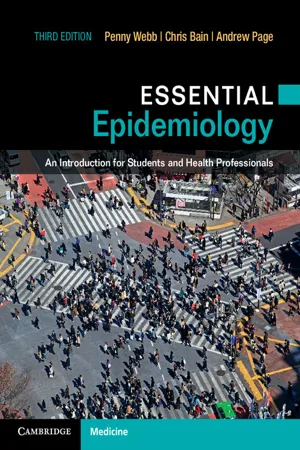
Essential Epidemiology
An Introduction for Students and Health Professionals
- English
- PDF
- Available on iOS & Android
Essential Epidemiology
An Introduction for Students and Health Professionals
About this book
Taking a practical approach and supported by global examples from all areas of health, the new edition of this popular and highly commended textbook has been updated to reflect current epidemiological thinking and teaching. Based on feedback from teachers and students, material has been reordered to better suit courses and reflect the underlying logic and purpose of epidemiology. • Provides students with a rounded picture of the field by emphasizing the commonalities across different areas of epidemiology, including clinical epidemiology, and highlighting the key role of epidemiology in public health • Avoids complex mathematics by restricting this to optional material, thereby keeping the book accessible to students from non-quantitative backgrounds • Integrated and supplementary questions help students to reinforce concepts • A wealth of online material is available at www.cambridge.org/essential_epidemiology, including additional questions, advanced material for key concepts, recommendations for further reading, links to useful websites and slides for teaching, supporting both students and teachers.
Frequently asked questions
- Essential is ideal for learners and professionals who enjoy exploring a wide range of subjects. Access the Essential Library with 800,000+ trusted titles and best-sellers across business, personal growth, and the humanities. Includes unlimited reading time and Standard Read Aloud voice.
- Complete: Perfect for advanced learners and researchers needing full, unrestricted access. Unlock 1.4M+ books across hundreds of subjects, including academic and specialized titles. The Complete Plan also includes advanced features like Premium Read Aloud and Research Assistant.
Please note we cannot support devices running on iOS 13 and Android 7 or earlier. Learn more about using the app.
Information
Table of contents
- Cover
- Half-title
- Title page
- Copyright information
- Table of contents
- Foreword
- Preface
- List of Contributors
- 1 Epidemiology is . . .
- 2 How long is a piece of string? Measuring disease frequency
- 3 Who, what, where and when? Descriptive epidemiology
- 4 Healthy research: study designs for public health
- 5 Why? Linking exposure and disease
- 6 Heads or tails: the role of chance
- 7 All that glitters is not gold: the problem of error
- 8 Muddied waters: the challenge of confounding
- 9 Reading between the lines: reading and writing epidemiological papers
- 10 Who sank the boat? Association and causation
- 11 Assembling the building blocks: reviews and their uses
- 12 Surveillance: collecting health-related data for epidemiological intelligence and public health action
- 13 Outbreaks, epidemics and clusters
- 14 Prevention: better than cure?
- 15 Early detection: what benefits at what cost?
- 16 Epidemiology and the public’s health
- Answers to questions
- Appendix 1 Direct standardisation
- Appendix 2 Standard populations
- Appendix 3 Calculating risk and lifetime risk from routine data
- Appendix 4 Indirect standardisation
- Appendix 5 Calculating life expectancy from a life table
- Appendix 6 Why the odds ratio approximates the relative risk for a rare disease
- Appendix 7 Formulae for calculating confidence intervals for common epidemiological measures
- Appendix 8 The Mantel-Haenszel method for calculating pooled odds ratios
- Glossary
- Index